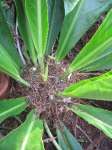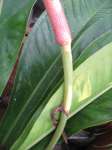| Dear Don and All,
Aloha.
According to recent posts and the literature about Anthurium section Pachyneurium, all(?) of the birdnest forms, except Anthurium hookeri, are Pachyneurium with involute vernation. I have this birdnest form Anthurium...photo files attached, that has supervolute vernation. It has very spicy, fragrant inflorescences. There is a long, naked stipe. Note the peduncle, old spathe attachment area, naked stipe, and inflorescence. Does anyone else grow this thing and does anyone have a name or data?
Aloha,
Leland --- On Wed, 1/20/10, Don Bittel <donbit121@hotmail.com> wrote:
From: Don Bittel <donbit121@hotmail.com>
Subject: Re: [Aroid-l] Supervolute vernation vs. convolute
To: "Discussion of aroids" <aroid-l@gizmoworks.com>
Date: Wednesday, January 20, 2010, 7:03 PM
=0A=0A=0A=0A =0ASteve, etc.,
I think these drawings do make sense of this. Philodendrons would be convolute, with a newly forming leaf inside of the opening leaf. Anthuriums would be supervolute, since they don't have that leaf inside the opening leaf. Antway, it is a fine distinction, and not that important for the average grower. But I have always watched out the involute anthuriums, the pachyneuriums, since they are not all birdnest types, and they usually breed with each other. I've made many crosses with heart shaped leaves crossed with linear leaved rosette types. I have had watermaliense cross with convolute/supervolute types like pedato-radiatum and dressleri. The leaves come out with a mix of involute and convolute. But I have never had a birdnest type cross outside of the pachynerium section, with a convolute type. So, I would guess that 99.999 percent of the anthurium 'hookeri' plants sold anywhere are definitely not hybrids of the true hookeri, since I doubt it could ever cross with pachyneriums. I hope to try some of these anyway, when my hookeri starts to flower.
Thanks for starting this confusing topic, Steve. It's been fun!
Don Bittel
Date: Wed, 20 Jan 2010 10:17:17 -0600 From: Steve@exoticrainforest.com To: aroid-l@gizmoworks.com; abri1973@wp.pl Subject: [Aroid-l] Supervolute vernation. Finally a photo! =0A=0A=0A=0A=0A =0A =0A=0A=0A I screwed up big time and=0Ainserted the wrong drawing.
=0A
=0AThese are the correct drawings from Stern's showing the placement of=0Athe midrib. It appears the only difference in supervolute and=0Aconvolute is a leaf forming around another leaf but frankly I still=0Adon't have a completely satisfactory explanation. I try almost daily on my website to make subjects like this clearer for=0Aanyone interested in aroids that does not have or is not interested in=0Aearning a degree in botany. I am now to the point of completely=0Aremoving the subject since I am no longer sure I fully understand it or=0Acan help anyone else to understand.
=0A
=0AI don't believe any definition in print in any of the 5 botanical=0Adictionaries I now own make the distinction (if any) between convolute=0Aand supervolute clear. At least in the dictionaries they appear to be=0Asynonymous and are one and the same.
=0A
=0ASteve
=0Awww.ExoticRainforest.com
=0A
=0A=0AMarek Argent wrote:=0A =0A =0A =0A =0A Steve, =0A =0A We cannot talk about vernation types=0Anot seeing the midrib as it is presented on the second drawing. =0A It can as well be a half of a leaf=0Arolled involutely. =0A =0A The third drawing (convolute) is=0Awhat I thought about (but I was afraid to say) - =0A that the term "convolute" may refer=0Aonly to at least two objects =0A like one leaf inside another one or=0Aa spadix wrapped by a spathe. =0A =0A Anyway in my cord photos, the third=0Atype, although probably not occuring in Araceae =0A is possible, so it must have a name=0Atoo. =0A =0A It's becoming complicated... =0A =0A Marek =0A =0A - =0A
=0A
=0A
=0A These drawings are from William T. Stern's Botanical Latin,=0A4th edition.
=0A
=0A
=0A =0A
=0A =09=09 =09 =09=09
Hotmail: Free, trusted and rich email service. Get it now. =0A
-----Inline Attachment Follows-----
|




